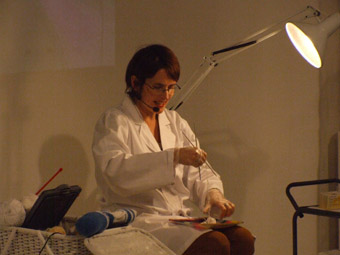Knit two together
Shady Cosgrove visits Catherine Fargher's BioHome

Catherine Fargher, BioHome
On entering a clinical gallery space, visitors are greeted with lab coats, infrared headsets and a sign instructing them to don both for “field safety.” Urging us into the exhibit, Catherine Fargher's smooth call-centre voice and equally plastic smile signal the commercial nature of the domestic and scientific realms under scrutiny in her performance, BioHome: the Chromosome Knitting Project. The laboratory-kitchen is equipped with blenders, skin care products, microscopes and beakers.
Two volunteers are selected from the audience to take part in a task to isolate snowpea DNA, the process enlarged by projection on the wall behind. Meanwhile, Fargher narrates, touching on matters from DNA retrieval to human cloning. Suddenly she falls to the floor, dropping a blue liquid vial that spatters across the linoleum. This strategy (where the uncooperative body interrupts the performance) is used throughout the 45-minute show to emphasise the physical tensions that aren't being addressed by Fargher's narration. Terumi Narushima's subtle, live soundtrack escalates the tension during these episodes.
After Fargher recovers, we turn to the white stage behind us where a baby basinet (the 'BioBasinet') on wheels cradles a stern, black microscope. Fargher sneaks a peak at the 'BioBaby' lifting the cover expectantly and cooing over the microscope slide of “little Thumbelina.” The performer's account of the merits of BioHome continues as she demonstrates “DNA knitting.”
“Knitting has become more than a craft”, she says, casting on the yarn and detailing how humans can be 'knit' through DNA modification and in-vitro fertilisation (IVF). As her needles click, she adds that helpful products such as the ChromoKnit Doll are available for purchase. Her sales pitch is periodically interrupted: at one point, she sings a lullaby and later, has to lie down because she feels ill from all the hormones she's been injecting in IVF treatment. This performance directly addresses the desperation that some women face to have children and their willingness to experiment on their bodies. For those who have undergone IVF, this may prove confronting.
At times the scope of the performance and exhibition seemed overly ambitious. Analysing the intersection of science and the home is an unwieldy endeavour and a few times I was left wondering at how Fargher prioritised her subject matter—how does one decide what to address and what to leave out? Importantly, however, this work demands that its audience consider the role of biotechnologies in contemporary Australia.
Even without the narration, the exhibit stands on its own. The infrared headsets offer safety instructions, a discussion on ethics and an interview with Jo Larret on IVF egg extraction. Perhaps the audience would miss the finer nuances that come with Fargher's performance (especially on the role of consumerism in this growing market). However, the juxtaposition of the scientific with the domestic—which drives the visual element of the show-is certainly evident.
BioHome: The Chromosome Knitting Project, performance & installation Catherine Fargher, live sound mix Terumi Narushima, August 16-25, FCA Gallery, Faculty of Creative Arts, University of Wollongong, www.biohomeproject.com
RealTime issue #75 Oct-Nov 2006 pg. 34






